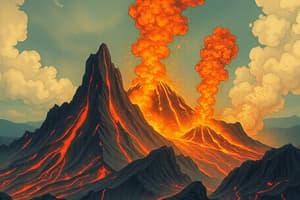Podcast
Questions and Answers
What are the three main categories of volcanic eruption based on how they release magma from deep within Earth?
What are the three main categories of volcanic eruption based on how they release magma from deep within Earth?
- Effuseful, eruptive, and mixed
- Effusive, effervescent, and explosive
- Expanding, effusive, and exploding
- Effusive, explosive, and mixed (correct)
Which type of eruption involves slow lava flows out of vents without significant blasts?
Which type of eruption involves slow lava flows out of vents without significant blasts?
- Explosive
- Eruptive
- Effusive (correct)
- Mixed
What is another term for explosive eruptions characterized by hot gas and rapidly exiting debris?
What is another term for explosive eruptions characterized by hot gas and rapidly exiting debris?
- Effusive eruptions
- Eruptive eruptions
- Pyroclastic eruptions (correct)
- Mixed eruptions
Which volcanic eruption type is known for generating large amounts of fine ash particles called tephra?
Which volcanic eruption type is known for generating large amounts of fine ash particles called tephra?
In an effusive eruption, what is the primary result of the lava flow?
In an effusive eruption, what is the primary result of the lava flow?
Which eruption type is classified based on slow lava flows and minimal ash production?
Which eruption type is classified based on slow lava flows and minimal ash production?
What is a tephra capable of doing, based on the text?
What is a tephra capable of doing, based on the text?
Which historic event is described as one of the deadliest and most destructive volcanic eruptions?
Which historic event is described as one of the deadliest and most destructive volcanic eruptions?
What distinguishes a mixed eruption from other volcanic eruptions?
What distinguishes a mixed eruption from other volcanic eruptions?
Where did Novarupta experience a mixed eruption in 1912?
Where did Novarupta experience a mixed eruption in 1912?
How do hybrid eruptions, as mentioned in the text, differ from other volcanic eruptions?
How do hybrid eruptions, as mentioned in the text, differ from other volcanic eruptions?
Why is understanding various forms of volcanic eruptions important?
Why is understanding various forms of volcanic eruptions important?
Flashcards are hidden until you start studying
Study Notes
Volcanoes are fascinating natural phenomena that have shaped our planet's landscape over millions of years through their explosive eruptive activity. Understanding different types of volcanic eruptions is crucial for predicting future eruptions and mitigating potential disasters. There are three main categories of volcanic eruption based on how they release magma from deep within Earth: effusive, explosive, and mixed. Each type has unique characteristics and can cause varying levels of destruction. Here we will delve into these types in detail.
Effusive Eruptions These occur when lava flows slowly out of vents, often creating new land or altering existing landscapes without significant blasts. Examples of such eruptions include Alaska's Mount Spurr, which emitted lava during its 1992 eruption, and Mount St. Helens, whose pumice flowed out after it exploded in 1857. Effusive eruptions typically involve less violent events like lava fountains rather than major ash clouds. A notable example is the 1980 eruption of Mount St. Helens, which was actually classified as an effusive eruption because it did not produce much ash—only a few thousand tons compared to the million tons expected in most explosive eruptions.
Explosive Eruptions In contrast, explosive eruptions, also called pyroclastic eruptions, involve hot gas and debris rapidly exiting the vent. These eruptions, characterized by powerful steam-driven explosions, generate large amounts of fine ash particles known as tephra. This tephra might travel thousands or even tens of thousands of kilometers away from the eruption site. One well-known historic event was Krakatoa’s explosion in 1883, described as one of the deadliest and most destructive volcanic eruptions in recorded history. Another famous instance occurred in Alaska around 27 million years ago; there, a massive caldera-forming eruption created Anaktuvuk Mountain, depositing layers of volcanic ash up to 3 meters thick across thousands of square miles.
Mixed Eruptions Sometimes, volcanoes exhibit traits from both effusive and explosive classifications. Such hybrid eruptions are termed mixed and represent another form of volcanism. For example, Novarupta, located near Mount Katmai National Park in Alaska, experienced a mixed eruption in 1912, involving both gaseous emissions and effusion of liquid materials into nearby areas before finally producing an enormous cloud of ash.
Understanding these various forms helps scientists better anticipate, track, and respond to potentially catastrophic events. It's clear that while some may seem more dramatic due to their destructive power and far-reaching effects, all types play integral roles in shaping our planetary system.
Studying That Suits You
Use AI to generate personalized quizzes and flashcards to suit your learning preferences.




